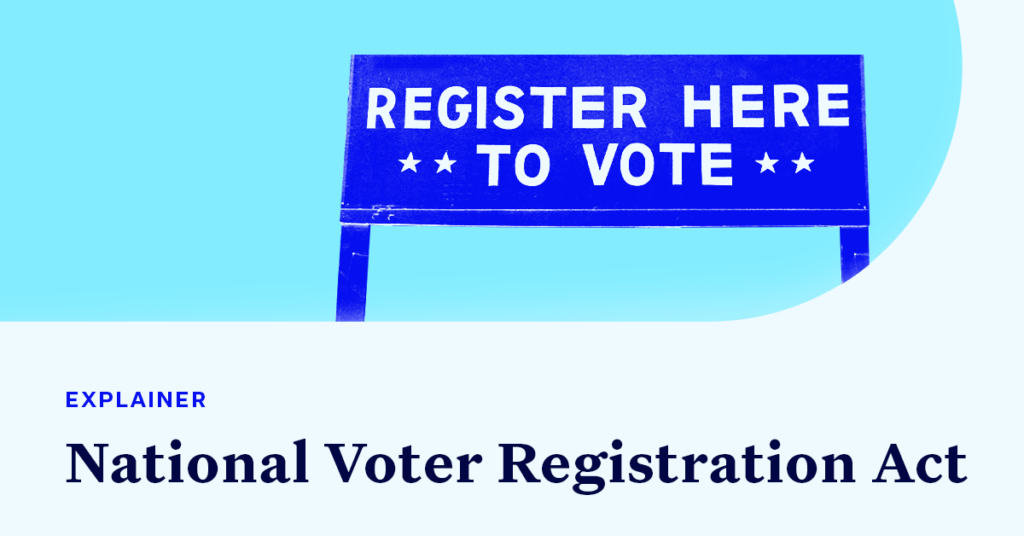The 1993 “Motor Voter” Law Helping You Register to Vote

Exercising your right to vote isn’t as simple as turning 18. In the United States, you first need to register to vote, a process that varies greatly between states. There’s one piece of federal legislation that has successfully expanded and protected the options for voter registration over the past three decades.
As other important legal tools used to protect voters — namely the Voting Rights Act of 1965 (VRA) — have been whittled away by the U.S. Supreme Court, the National Voter Registration Act of 1993 (NVRA) remains a robust, powerful protection for this vital, first step in the voting process.
Why do we need national legislation around voter registration?
Since voter registration determines whether or not someone can cast a ballot, it has historically been a focus point for those who wish to prevent Black voters from taking part in the political process. In the time period after Reconstruction, states enacted arbitrary or complex voter registration requirements, and granted incredible discretion to the registrars themselves. Before his time in Congress, former U.S. Rep. John Lewis (D-Ga.) served as the director of the Voter Education Project. In 1972, he explained how in many places in the South, registration boards were dominated by “party hacks” and “set up rules and regulations and other barriers to the ballot which make it impossible for poor people and working people to register with ease.”
Explicit disenfranchising tools were made illegal by the VRA in 1965. But, voter registration remained a complicated obstacle that greatly contributed to the low rates of voter turnout in the country. In many other democracies, the government assumes responsibility for voter registration, not the individual.
In the 1980s, Congress focused on making voter registration more accessible for groups that faced heightened barriers, enacting the Voting Accessibility for the Elderly and Handicapped Act of 1984 and the Uniformed and Overseas Citizens Absentee Voting Act of 1986. The first NVRA passed by Congress was vetoed by President George H. W. Bush in 1991. The nearly identical bill was signed into law by President Bill Clinton just two years later.
What does the NVRA do?
The NVRA is often referred to as the “Motor Voter” law for its focus on voter registration opportunities when interacting with state Departments of Motor Vehicles (DMV), but it does much more than that. While the law technically only applies to federal elections, all states have unified voter registration systems and have extended the NVRA’s processes to state elections as well.
The NVRA only covers 44 states and Washington, D.C.; Idaho, Minnesota, New Hampshire, North Dakota, Wisconsin and Wyoming have no voter registration requirement or have continually offered Election Day registration since Aug. 1, 1994.
Section 5 of the NVRA outlines the voter registration opportunities at motor vehicle agencies. This provision requires a driver’s license application, including renewal or change of address updates, to simultaneously serve as a voter registration application. Under the NVRA, the motor vehicle agency must transmit the voter registration portion of the license application to the relevant state elections office within 10 days after accepting the application.
Section 7 of the NVRA similarly sets guidelines for offering voter registration services at government agencies that provide public assistance, including federal programs like the Supplemental Nutrition Assistance Program (SNAP), the Special Supplemental Nutrition Program for Women, Infants and Children (WIC), Medicaid and more. The provision also requires voter registration opportunities at recruitment offices for the U.S. armed forces as well as state-funded programs that primarily serve people with disabilities.
The NVRA requires states to maintain a list maintenance program to remove voters who have died or moved. Since our country doesn’t have a database of registered voters or a national ID system, states use other data sources to identify voters, such as U.S. Postal Service change of address forms, DMV records or information-sharing databases such as ERIC. The NVRA includes some safeguards to protect voters: The law limits changes close to an election and outlines requirements to notify voters before removal for change of residence reasons. Unfortunately, the legitimate practice of voter roll maintenance can easily become problematic voter purging.
Finally, the NVRA requires states to “accept and use” a mail-in federal voter registration form. On the federal form, voters simply have to check a box attesting they are a citizen and fulfill other eligibility requirements. Arizona has tried (and tried again) to enact documentary proof of citizenship laws, but the U.S. Supreme Court ruled in 2013 that Arizona must accept these federal forms because the NVRA preempts Arizona’s citizenship requirement.
Voter registration may be shifting, but the NVRA remains an important legal protection.
Less than 22 months after the NVRA’s enactment, a report found that “voter registration in States covered by the NVRA rose in 1996 by 1.82 percentage points — or some 3,390,000 people — over 1992, the previous comparable election.” Even in recent years, states’ DMVs remain the most commonly used registration source, accounting for around 40% of the total registrations received between the 2018 and 2020 general elections.
The NVRA was a resounding success in the 1990s, engaging voters with the registration process where they were — the DMV. Today, online options are on the rise, but voter registration remains a convoluted process in too many states.
There have been recent lawsuits that successfully enforced the NVRA in Alaska, Kansas and South Dakota, often initiated by the U.S. Department of Justice. Three decades later, the law continues to be an important legal tool to ensure states offer robust voter registration opportunities.